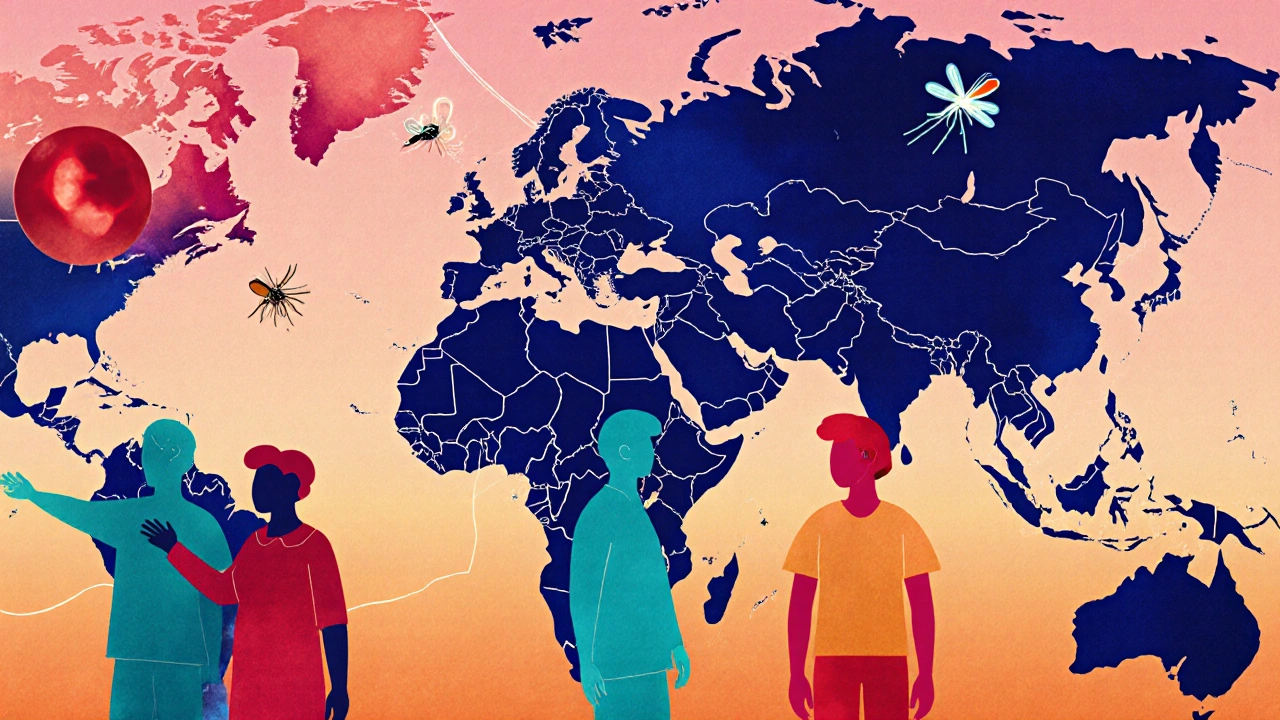
When you hear Malaria is a mosquito‑borne disease caused by Plasmodium parasites, you probably picture fevers and sweltering tropical nights. What if the key to ending those nights lives inside our own DNA? Over the past decade, scientists have been pairing the power of the human genomethe complete set of genetic instructions in every cell with the biology of the malaria parasite to hunt down hidden weaknesses. This article walks you through the most exciting breakthroughs, why they matter, and how they could finally deliver a cure.
For years the battle was one‑sided: drug developers chased the parasite, while humans simply endured the symptoms. Whole‑genome sequencing flipped that script. By scanning millions of people from malaria‑endemic regions, researchers discovered genetic variants that either shield people from infection or make them more vulnerable.
One famous example is the Duffy antigena protein on red blood cells that Plasmodium vivax uses to enter the cell. A simple mutation that silences the Duffy gene essentially blocks P. vivax, explaining why sub‑Saharan Africans are rarely infected by that species. Another protective trait is the sickle cell traita single‑letter change in the HBB gene that produces abnormal hemoglobin. People who carry one copy of this mutation are far less likely to suffer severe malaria caused by Plasmodium falciparumthe deadliest malaria parasite.
These natural experiments gave scientists a map of which genes influence infection risk, drug response, and immunity. The map is now guiding everything from new drug targets to personalized vaccine strategies.
Understanding the parasite’s own genome is just as crucial. The Plasmodium falciparum genomeabout 23 megabases of DNA spread across 14 chromosomes has been fully sequenced since 2002, but high‑resolution studies only became routine with next‑generation sequencing. Today, researchers can compare field isolates from Tanzania, Myanmar, or the Amazon in a single run, spotting mutations that confer drug resistance or alter antigenic proteins.
When a mutation in the parasite’s kelch13 gene first appeared in Southeast Asia, the genome database flagged it as a potential artemisinin resistance marker. That early warning gave health ministries time to adjust treatment policies before the resistant strain spread worldwide.
Enter CRISPR‑Cas9a precise gene‑editing tool that can cut and rewrite DNA. The technology is being used in two complementary ways.
Both approaches still face regulatory, ethical, and ecological hurdles, but the genetic toolbox is finally robust enough to turn theory into field‑ready interventions.
Vaccination has been the holy grail for malaria control. The first approved vaccine, RTS,S/AS01 (also called Mosquirix), offers about 30% protection in children-helpful, but not a game‑changer. Genomic data is now fueling the next generation of candidates.
By sequencing the parasite’s surface proteins across thousands of isolates, researchers identified conserved regions that rarely mutate. These “genomic sweet spots” are being fused into multi‑epitope vaccines, such as the R21/Matrix-Ma high‑density virus‑like particle vaccine that showed 77% efficacy in a 2022 trial in Burkina Faso.
Another promising direction is mRNA vaccinesplatforms that deliver genetic instructions to produce antigen proteins in the body, the same technology that powered COVID‑19 shots. Researchers are already testing mRNA constructs that encode the most conserved Plasmodium antigens, hoping for rapid, adaptable production.

| Trait | Gene Involved | Protective Effect | Population Frequency |
|---|---|---|---|
| Duffy‑null | ACKR1 (DARC) | Blocks P. vivax entry | ≈ 95% in West/Central Africa |
| Sickle cell trait (HbAS) | HBB | Reduces severe P. falciparum | 10‑15% in sub‑Saharan Africa |
| G6PD deficiency | G6PD | Impairs parasite growth | 5‑10% in malaria zones |
| Alpha‑thalassemia | HBA1/HBA2 | Moderate protection | 2‑8% in SE Asia & Africa |
These data help public‑health officials predict where certain interventions will be most effective. For instance, drug regimens that cause oxidative stress work better in G6PD‑deficient populations, while vaccines targeting P. vivax are less urgent in Duffy‑null regions.
Even with a treasure trove of genomic information, turning discoveries into a cure isn’t straightforward.
Organizations like the World Health Organization (WHO)the UN agency directing international health matters are already drafting guidelines for gene‑editing trials and gene‑drive releases, aiming to standardize safety protocols worldwide.
Putting the pieces together yields a fairly clear roadmap:
When those steps sync, the promise of a malaria‑free world moves from dream to measurable target.
Certain genetic changes-like the Duffy‑null mutation, sickle cell trait, and G6PD deficiency-alter red‑blood‑cell properties so the parasite can’t invade or grow as efficiently. These traits are more common in regions where malaria has been endemic for centuries.
CRISPR isn’t a stand‑alone cure yet, but early trials are editing stem cells to mimic protective mutations without causing disease. If safety and efficacy are proven, such edited cells could give individuals long‑lasting resistance.
Gene‑drive mosquitoes carry a CRISPR construct that spreads a trait making them unable to host Plasmodium. Trials in limited areas show a rapid drop in infection rates, but ecological impact assessments are still ongoing to ensure they don’t disrupt ecosystems.
The parasite constantly changes its surface proteins to evade immunity. Genomic studies are helping scientists identify the most stable proteins, but developing a vaccine that works across all strains remains a complex puzzle.
Donating to organizations that fund genomic research, supporting malaria‑free initiatives, and advocating for equitable access to new therapies are concrete ways to help. Even spreading awareness about the role of genetics can drive policy change.
19 Responses
Honestly, the whole CRISPR‑mosquito saga feels like a sci‑fi novella that somehow slipped into a peer‑reviewed journal. The Duffy‑null thing? Classic example of nature doing the heavy lifting while we try to catch up. Still, the jargon‑laden prose in these papers can be a bit dense for the layperson, ya know?
Great point! The Duffy‑null mutation is indeed a fascinating natural resistance. It’s also a reminder of why population genomics is essential for targeting interventions where they’re most needed.
Reading about the interplay between human genetics and malaria feels like uncovering a hidden chapter of our collective history. The way sickle‑cell carriers gain protection is nothing short of poetic, a bittersweet symphony of evolution. It’s a powerful illustration of how our ancestors’ struggles have shaped the very code inside us.
Indeed, the evolutionary narrative is both humbling and inspiring. The meticulous sequencing efforts across endemic regions showcase not only scientific rigor but also a profound respect for the communities involved. Such collaborative endeavors are paramount for translating genomic insights into tangible health solutions.
Adding to that, integrating these genomic datasets with local health infrastructure can streamline targeted drug distribution. It’s a practical step that bridges cutting‑edge research with on‑the‑ground impact.
The sequencing revolution has truly reshaped our battle against malaria, and the implications are staggering. First, whole‑genome analyses have illuminated how diverse human populations harbor protective alleles, like the Duffy‑null and sickle‑cell traits, that act as natural barricades against different Plasmodium species. Second, by cataloguing these variants across millions of genomes, researchers can pinpoint which genes confer the strongest resistance, guiding the design of novel therapeutics. Third, the high‑resolution parasite genome maps reveal the exact mutations that drive drug resistance, allowing for timely updates to treatment protocols before resistance spreads unchecked. Fourth, CRISPR‑based approaches now enable us to recreate protective mutations in stem cells, offering a potential long‑term, disease‑free blood supply for at‑risk individuals. Fifth, gene‑drive mosquitoes, though controversial, demonstrate that we can biologically suppress transmission vectors in a sustainable manner. Sixth, the latest mRNA vaccine platforms, inspired by COVID‑19 successes, are being repurposed to encode conserved Plasmodium antigens, promising rapid and adaptable vaccine production. Seventh, integrating genomic surveillance with mobile health units ensures real‑time monitoring of both human and parasite evolution in remote settings. Eighth, community engagement remains essential; without local trust, even the most advanced genomic tools will falter. Ninth, ethical frameworks must evolve alongside technology to address concerns about gene editing and ecological impacts. Tenth, sustained funding is the lifeblood of these initiatives, as intermittent support leads to fragmented data and lost momentum. Eleventh, interdisciplinary collaborations between geneticists, entomologists, clinicians, and policy makers create a synergistic ecosystem for innovation. Twelfth, education campaigns demystify genetics for the public, reducing stigma and fostering participation in studies. Thirteenth, regulatory harmonization across borders accelerates the deployment of breakthrough interventions. Fourteenth, open‑source data repositories promote transparency and accelerate discovery. Finally, when all these pieces align, the vision of a malaria‑free world shifts from an aspirational dream to an attainable reality.
It is all well and good to sing praises for CRISPR, yet one must wonder who truly controls the narrative. The powers that be rarely disclose the full extent of their manipulation. While gene‑drives may reduce malaria, they also set a precedent for unforeseen ecological cascade.
Appreciate the balanced take on gene‑drive mosquitoes. It’s vital we pair such technologies with robust community outreach so that locals feel ownership rather than imposition. Together, science and empathy can pave the way for sustainable change.
Totally agree – community buy‑in is key 😊 the genomic data alone isn’t enough without local legends and practices that respect the land.
From a philosophical standpoint, the convergence of human genomics and malaria eradication symbolizes hope emerging from our own biological narrative. Every protective allele represents a story of survival, and by decoding these stories we honor past generations while safeguarding future ones.
What a beautiful way to frame the science! It reminds us that data isn’t just numbers-it’s the echo of countless lives persevering against a relentless foe. By translating those echoes into vaccines and therapies, we can finally give those silent heroes their due.
While the sentiment is uplifting, let’s not overlook that many of these "protective alleles" are still linked to severe health issues in homozygotes. The oversimplification can mislead policymakers into underestimating the trade‑offs.
Appreciate the nuanced view. It's crucial we stay grounded in both the promise and the pitfalls.
Exactly, balance is essential.
The article glosses over the regulatory labyrinth that will inevitably stall these "groundbreaking" CRISPR projects. In practice, bureaucratic inertia and funding volatility will render most of these breakthroughs academic footnotes.
True, the red‑tape can be a real bottleneck.
Loved the deep dive into genomic surveillance! 🚀📊 It's amazing how portable sequencers are democratizing data collection in remote clinics.
Yeah, data pipelines are getting slick, but we still need good old‑school fieldwork to validate the numbers.
Exactly, marrying tech with hands‑on sampling will keep the research grounded and effective.